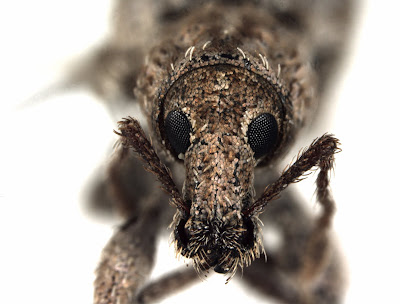Face of an unidentified Irenimus species.
Mouthparts are important. They are the entry point for the energy required by animals, and their form and structure can tell us something about the life and habitat of the creature in question. Insects have amazing mouthparts: consider the straw-like tube possessed by butterflies, the spongy pad used by blowflies, and the stilettos used by mosquitoes. What's even more incredible, is that it is modifications to the same four main structures that make up these very different structures. These structures are most easily seen in insects with biting mouthparts, such as grasshoppers or beetles. Their names and functions are as follows:
- The topmost structure is the labrum. This structure is a plate that prevents food from escaping out the top. Human analogy: upper lip or palate.
- The second strucure are the mandibles. These are a pair of large, strong, hardened plates that crush food into small particles that can be easily digested. Human analogy: teeth.
- The third structure are termed the maxillae (singular: maxilla). These are paired structures (like the mandibles) that help manipulate food, and also possess palps that contain banks of hairs and sensors that help the insect make sure that it's eating what it's supposed to. Human analogy: tongue.
- The fourth and final structure is the labium. This is a plate that stops food escaping out of the bottom of the mouth, similar to the labrum (notice the "R"), except that it also possessed palps like the maxillae. Human analogy: lower lip or lower jaw.
Maxilla (left) and labium (right) of Apotomoderes lateralis. Scale bars 0.2 mm and 0.1 mm respectively. Courtesy of Franz 2010. License: CC: BY
Weevils have their mouthparts at the end of the rostrum, and can just be seen in the photo at the top of the page. The structures listed above are possessed by weevils, with the exception of the labrum which is fused with the rest of the rostrum. In the picture above (taken from Franz 2010) you can see a maxilla on the left, and the labium on the right. They have not illustrated the mandibles, which can be pretty beefy in some species (such as Irenimus), but you can just see them at the tip of the rostrum in the photo above.
One of the question I hope to answer as part of my PhD is: do the mouthparts of Irenimus species reflect their environmental preferences? A reasonably straightforward question. Unfortunately, in order to look at their mouthparts, they need to be dissected out. This is easier said than done, as the mouthparts of weevils are very small and it takes a bit of fiddly microscope work to dissect them out. I tried my hand at it this week, following the methods used by Steve Davis in his work on baridine weevils, and successfully managed to get my first glimpse of weevil mouthparts. It will take a lot more dissecting to get to grips with some of the details, but the ice has been broken!
References:Davis SR. 2009. Morphology of Baridinae and related groups (Coleoptera, Curculionidae). ZooKeys 10: 1–136.
Franz NM. 2010. Revision and phylogeny of the Caribbean weevil genus Apotomoderes Dejean, 1834 (Coleoptera, Curculionidae, Entiminae). ZooKeys 49: 33–75.
Read:
Wilson D. 2010. The People's Bible. The Remarkable History of the King James Version. Oxford: Lion
McCulloch D. 2010. A History of Christianity: The First Three Thousand Years London: Penguin
Psalms 55–59, Genesis 1:2 Websites:
Deep Thoughts and Silliness—a nature network blog by Bob O'Hara
Ubuntu 12.04 screensavers
Changing default applications Listened:
Astor Piazzolla—Octeto Buenos Aires Watched:
Star Trek: Deep Space Nine Season 3
Norma Jean—Kill More Presidents Music video


No comments:
Post a Comment